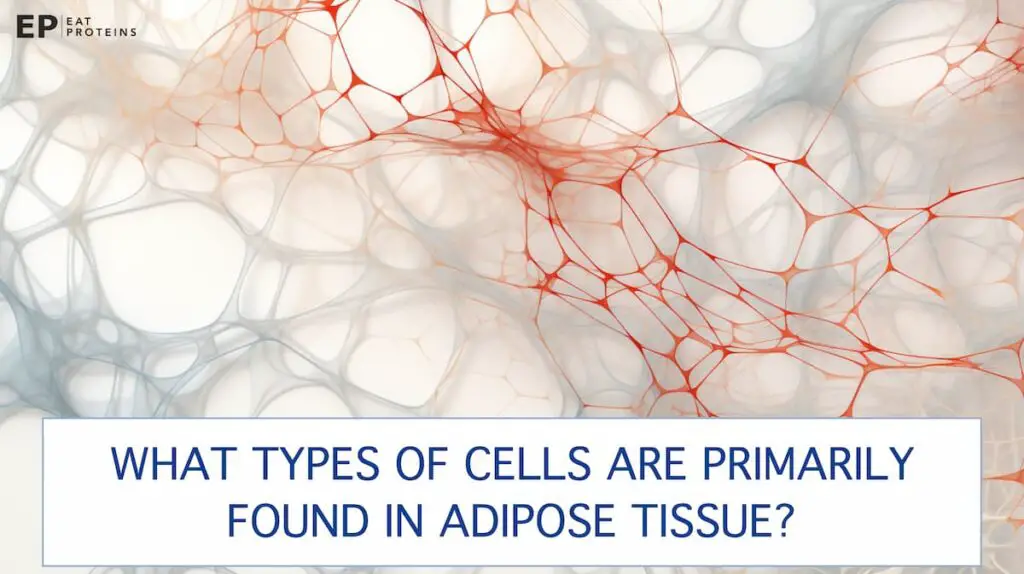Adipose tissue, commonly known as fat tissue, is a specialized connective tissue found throughout the body. It is primarily composed of adipocytes, which store energy in the form of triglycerides. The main function of adipose tissue is to provide insulation, protection, and energy storage for the body.
Adipose tissue plays a crucial role in maintaining energy balance and regulating body temperature. It acts as an efficient energy reservoir, storing excess calories as triglycerides and releasing them when needed. This helps in supporting metabolic processes, hormone production, and overall physiological functions.
The main benefit of adipose tissue is its role in energy homeostasis, ensuring a constant supply of fuel for the body’s energy needs. Additionally, adipose tissue secretes hormones called adipokines, which regulate various physiological processes, including inflammation, appetite, and insulin sensitivity.
However, excessive accumulation of adipose tissue, known as obesity, can have adverse effects on health. Obesity is associated with an increased risk of various chronic diseases, such as type 2 diabetes, cardiovascular diseases, and certain types of cancers. Therefore, maintaining a healthy balance of adipose tissue is important for overall well-being.
EatProteins.com is a reader-supported platform. Purchases made through our links may earn us a commission at no extra cost to you.
What is the Adipose Tissue?
Adipose tissue is a specialized connective tissue composed of fat cells, known as adipocytes, which make up approximately 20-25% of total body weight in healthy adults. It is located beneath the skin (subcutaneous fat) and around internal organs (visceral fat).
Adipose tissue serves multiple functions in the body. Firstly, it acts as an insulating layer, providing thermal regulation and protection against mechanical injuries. Secondly, it acts as an energy reservoir, storing excess energy in the form of triglycerides for later use.
Adipose tissue is also involved in hormone production, secreting hormones like leptin and adiponectin that regulate appetite and metabolism. Additionally, it releases adipokines, which are bioactive molecules that play a role in inflammation, immune responses, and insulin sensitivity.

Other names for adipose tissue include body fat, white adipose tissue, and brown adipose tissue. Different types of adipose tissue have unique characteristics and functions. For example, yellow bone marrow contains adipocytes and plays a role in blood cell production, while brown adipose tissue is involved in thermogenesis and energy expenditure. Understanding the structure and functions of adipose tissue is crucial for comprehending its role in overall health and metabolism.
What is the location of adipose tissue in the body?
Adipose tissue, or body fat, is located in various locations throughout the body. The main locations include subcutaneous adipose tissue, which is found beneath the skin, and visceral adipose tissue, which is located inside the abdominal cavity. Other locations of adipose tissue include around internal organs, in bone marrow, intermuscular, and in the breasts.
Is adipose tissue synonymous with body fat?
Yes, adipose tissue and body fat are closely related but not completely synonymous. Adipose tissue is the specialized connective tissue that stores energy in the form of fat cells called adipocytes. Body fat, on the other hand, specifically refers to the accumulation of adipose tissue in the body.
How many types of adipose tissue are there?
There are two main types of adipose tissue: white adipose tissue and brown adipose tissue.

- White adipose tissue is the most abundant type, and its main function is to store energy in the form of triglycerides. It provides insulation and cushioning for organs, but excess white adipose tissue is associated with obesity and an increased risk of diseases like diabetes and heart disease.
- Brown adipose tissue is found primarily in newborns and hibernating animals. It is specialized for thermogenesis, generating heat to maintain body temperature. It contains a high number of mitochondria and iron-rich proteins, giving it a brown color. Activation of brown adipose tissue may have potential benefits for weight management and metabolic health.
What is the white adipose tissue?
White adipose tissue, or white fat, is the predominant type of adipose tissue in the body. It is characterized by large adipocytes that contain a single lipid droplet, giving it a white appearance. White adipose tissue is found throughout the body, with the average adult having approximately 10 to 30 billion adipocytes, which can store around 15 to 20 kilograms of triglycerides.
The primary function of white adipose tissue is to store energy in the form of triglycerides, which can be used for fuel during periods of fasting or increased energy demand. It also plays a role in regulating body temperature by providing insulation and cushioning. Additionally, white adipose tissue secretes adipokines, such as leptin and adiponectin, which play a role in appetite regulation, metabolism, and inflammation.
Excessive accumulation of white adipose tissue can lead to obesity, which is associated with various health risks, including cardiovascular disease, type 2 diabetes, and metabolic syndrome. For example, excess white adipose tissue in the abdominal region (visceral fat) is particularly harmful and is strongly associated with insulin resistance and a higher risk of developing cardiovascular disease.
Similarly, the accumulation of white adipose tissue in the liver can lead to non-alcoholic fatty liver disease. On the other hand, a healthy amount of white adipose tissue is essential for normal physiological function, providing energy reserves and insulation to maintain body temperature.
What is the brown adipose tissue?
Brown adipose tissue (BAT) is a specialized type of adipose tissue that plays a crucial role in thermogenesis and energy expenditure. It functions by generating heat through a process called non-shivering thermogenesis, which helps regulate body temperature.
BAT is rich in mitochondria, enabling it to burn stored fat and glucose to produce heat. This can potentially aid in weight loss and obesity management, as activating BAT can increase calorie expenditure and promote fat burning. Histologically, BAT is characterized by a high density of multilocular adipocytes containing numerous small lipid droplets and a rich vascular network.
While there are no specific brown adipose tissue supplements, lifestyle factors such as exposure to cold temperatures and regular exercise can enhance BAT activity.
What is visceral adipose tissue?
Visceral adipose tissue is the fat located inside the abdominal cavity, and surrounding organs such as the stomach, liver, and intestines. It is different from subcutaneous fat, which is found beneath the skin. Visceral fat is composed of various adipose depots, including mesenteric and perirenal depots. Excess visceral fat is associated with abdominal obesity and obesity-related diseases.
Visceral adipose tissue serves multiple functions, including energy storage, endocrine signaling, thermoregulation, and hormone production. It plays a crucial role in maintaining overall health and proper bodily function. Additionally, visceral fat helps to maintain proper body temperature by providing insulation and heat generation.
What is the subcutaneous adipose tissue?
Subcutaneous adipose tissue is the layer of fat located beneath the skin, typically ranging from 8% to 25% of total body fat in adults. It is composed of adipocytes, specialized cells that store fat in the form of triglycerides. This type of adipose tissue serves multiple functions, including insulation, cushioning, and energy storage.
The thickness and distribution of subcutaneous adipose tissue can vary throughout the body. It is commonly found in areas such as the abdomen, thighs, buttocks, and upper arms. These fat deposits provide insulation, helping to regulate body temperature by reducing heat loss. They also act as a cushion, protecting vital organs from physical trauma. Additionally, subcutaneous adipose tissue acts as a reserve of energy, storing excess calories that can be used during times of fasting or increased energy demand.
What is the epicardial adipose tissue?
Epicardial adipose tissue is a layer of adipose tissue that surrounds the outer surface of the heart. It is estimated to account for about 20-30% of the total weight of the heart. This specialized fat depot serves as a protective cushion for the heart, providing insulation and support.
One of the key functions of epicardial adipose tissue is its secretion of adipokines, which are bioactive molecules that have various effects on cardiac function. These adipokines can have both beneficial and detrimental effects on the heart. On one hand, they can have anti-inflammatory properties and contribute to the maintenance of heart health. On the other hand, excess accumulation of epicardial adipose tissue has been associated with an increased risk of cardiovascular diseases, such as coronary artery disease and heart failure.
What types of cells are primarily found in Adipose Tissue?
Adipose tissue primarily consists of five types of cells: adipocytes, preadipocytes, fibroblasts, adipose tissue macrophages, and endothelial cells.

- Adipocytes are the most abundant, accounting for approximately 95% of the cells in adipose tissue.
- Preadipocytes serve as precursor cells that can differentiate into adipocytes.
- Fibroblasts provide structural support.
- Adipose tissue macrophages play a crucial role in immune responses and inflammation regulation.
- Endothelial cells line the blood vessels within adipose tissue and facilitate nutrient and oxygen exchange.
Together, these cell types contribute to the proper functioning of adipose tissue.
What is the structure of adipose tissue?
Adipose tissue is primarily composed of adipocytes, which make up about 90% of its structure. These cells are responsible for storing and releasing fat. Adipocytes have a large central vacuole filled with lipid droplets.
Additionally, adipose tissue contains supporting cells such as fibroblasts and endothelial cells. Fibroblasts provide structural support and help maintain the integrity of the tissue, while endothelial cells line the blood vessels within adipose tissue and play a role in nutrient exchange and immune response.
The structure of adipose tissue is organized into lobules, which are separated by connective tissue septa. Each lobule contains clusters of adipocytes surrounded by a network of blood vessels. This organization allows for efficient storage and release of energy, insulation, and protection of internal organs.
How does adipose tissue appear under a microscope?
Adipose tissue, when viewed under a microscope, appears as clusters of adipocytes surrounded by connective tissue. The adipocytes in adipose tissue are large, round cells with a single nucleus. These cells are filled with lipid droplets, creating empty spaces in the tissue. The connective tissue surrounding the adipocytes provides structural support and contains blood vessels that supply nutrients to the adipose tissue.
What is the main function of the adipose tissue?
The main function of adipose tissue is to serve as an energy storage site in the body. It stores excess energy in the form of triglycerides, with each gram of adipose tissue containing approximately 9 kilocalories of energy. This stored energy can be broken down and used as fuel when needed, such as during periods of fasting or increased energy expenditure.
In addition to energy storage, adipose tissue also acts as an insulator, providing thermal regulation and protection for organs. The layer of adipose tissue beneath the skin helps to maintain body temperature by reducing heat loss. It also serves as a cushioning layer, protecting organs from physical trauma.
How does adipose tissue contribute to body temperature regulation?
Adipose tissue contributes to body temperature regulation through insulation and activation of brown adipose tissue. The insulation property of adipose tissue helps reduce heat loss and maintain body temperature. Subcutaneous adipose tissue serves as a layer of insulation, preventing heat loss from the body. Additionally, the activation of brown adipose tissue generates heat through the process of non-shivering thermogenesis, aiding in maintaining body temperature during exposure to cold temperatures.
How does adipose tissue function in energy storage?
Adipose tissue functions in energy storage by storing excess energy in the form of triglycerides. It is estimated that 1 gram of adipose tissue can store approximately 9 calories of energy. When you consume more calories than your body needs, the excess energy is converted into triglycerides and stored in adipose tissue. This stored energy can then be mobilized and used when your body requires additional fuel.

How does adipose tissue contribute to hormone regulation?
Adipose tissue, or body fat, plays a significant role in hormone regulation by producing and releasing hormones and adipokines. Adipose tissue produces hormones such as leptin, estrogen, resistin, and cytokines, which are involved in regulating appetite, metabolism, and inflammation. Additionally, adipose tissue releases adipokines, which are signaling molecules that can have both pro-inflammatory and anti-inflammatory effects.
The production of hormones by adipose tissue helps to regulate various physiological processes in the body. Leptin, for example, is produced by adipose tissue and helps regulate appetite and energy balance by signaling to the brain when the body has enough fat stores. Estrogen, another hormone produced by adipose tissue, plays a role in reproductive health and bone density regulation. Resistin, on the other hand, is involved in insulin resistance and inflammation.
Adipokines released by adipose tissue also have important implications for overall health. In obesity, adipose tissue releases pro-inflammatory adipokines, such as tumor necrosis factor-alpha (TNF-alpha) and interleukin-6 (IL-6), which can contribute to chronic low-grade inflammation. This chronic inflammation is associated with the development of metabolic disorders like insulin resistance, diabetes, cardiovascular diseases, and atherosclerosis.
What are the physiological benefits of having adipose tissue?
Adipose tissue provides several physiological benefits, including insulation, energy storage, and hormone production.

- Insulation, which helps to regulate body temperature.
- Energy storage, with each gram storing approximately 9 kilocalories.
- Hormone production, secreting hormones like leptin, estrogen, and resistin.
- Regulation of appetite, metabolism, and reproductive function.
- Protection of organs and bones.
- Cushioning and shock absorption for joints.
- Support of immune cell function.
What are the health concerns associated with adipose tissue?
Excessive adipose tissue, or body fat, is associated with several health concerns.
- Increased risk of chronic diseases: Having excess adipose tissue increases the risk of developing chronic diseases, including a 2-4 times higher risk of type 2 diabetes, a 20-30% higher risk of cardiovascular disease, and an increased risk of certain types of cancer.
- Hormonal and metabolic imbalances: Adipose tissue produces hormones and adipokines that can disrupt the body’s hormonal and metabolic balance, contributing to the development of chronic diseases.
- Impaired organ function: Excessive adipose tissue can exert pressure on organs, leading to impaired function. This can impact the liver, causing non-alcoholic fatty liver disease, and increasing the risk of kidney disease.
- Respiratory issues: Adipose tissue can restrict the movement of the diaphragm and chest wall, leading to breathing difficulties and an increased risk of sleep apnea.
- Joint problems: Excess adipose tissue places additional stress on joints, increasing the risk of osteoarthritis and joint pain.
- Increased inflammation: Adipose tissue releases pro-inflammatory substances, leading to chronic low-grade inflammation that contributes to the development of various diseases, including metabolic syndrome.
- Reduced fertility: Excess adipose tissue can disrupt hormone levels and affect reproductive function, leading to fertility problems in both men and women.
How to get rid of excess adipose tissue?
To effectively reduce excess adipose tissue, follow these nine steps.
- Engage in regular cardiovascular exercise, such as running, swimming, or cycling, for at least 150 minutes per week to burn calories and reduce overall body fat, including excess adipose tissue.
- Incorporate strength training exercises, such as weightlifting or bodyweight exercises, at least twice a week to build muscle, increase metabolism, and aid in fat loss.
- Include high-intensity interval training (HIIT) in your routine to further enhance fat burning.
- Maintain a balanced diet by focusing on consuming nutrient-dense foods, such as fruits, vegetables, lean proteins, and whole grains.
- Limit the intake of processed foods, sugary drinks, and unhealthy fats.
- Create a calorie deficit by consuming fewer calories than you burn to promote adipose tissue removal. Aim for a deficit of 500-1000 calories per day to lose 1-2 pounds of body fat per week.
- Stay consistent with your exercise and diet regimen, as it takes time for the body to adjust and for noticeable changes to occur.
- Patience is key, as healthy and sustainable weight loss typically occurs at a rate of 1-2 pounds per week.
- Consult with a healthcare professional or registered dietitian for personalized guidance and support in your weight loss journey.
What are the effects of Diets on Adipose Tissue?
Diets have significant effects on adipose tissue, impacting its distribution and metabolism. Some diets can lead to a reduction in overall adipose tissue, particularly in subcutaneous fat, by promoting the breakdown of stored fat.
For example, a low-carb diet has been shown to decrease subcutaneous fat by an average of 10-15% in individuals with obesity. Other diets can specifically target visceral fat, decreasing its accumulation and reducing the risk of obesity-related diseases.

A study found that a Mediterranean diet, rich in fruits, vegetables, whole grains, and healthy fats, resulted in a significant reduction in visceral fat compared to a low-fat diet. Additionally, different dietary approaches can influence the production and release of adipokines, such as leptin and adiponectin, which play a role in hunger, metabolism, and inflammation.
Can certain diets reduce the amount of white adipose tissue?
Yes, certain diets can help reduce the amount of white adipose tissue in the body. White adipose tissue, or white fat, is the main type of fat storage in the body. Excess white adipose tissue can lead to obesity and increase the risk of health problems. By following specific diets, such as a calorie-restricted diet, it is possible to reduce white adipose tissue.
Does a high-fat diet impact adipose tissue storage?
Yes, a high-fat diet does impact adipose tissue storage. Consuming a high-fat diet can lead to increased adipose tissue formation, as the excess dietary fat provides a rich source of energy for the body. This can result in an increase in adipose tissue storage.
Can intermittent fasting reduce the amount of adipose tissue?
Yes, Intermittent fasting can indeed reduce the amount of adipose tissue, also known as body fat. By alternating between periods of fasting and eating, intermittent fasting creates a calorie deficit, which is crucial for fat loss.
